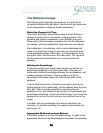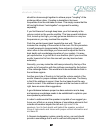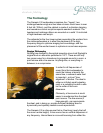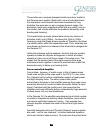
22
2222
22
absolute fidelity
ribbon/electrostatic designs without the high distortion and poor
dispersion that is typically associated with them.
The G2.2 uses twelve of these tweeters configured as a vertical
line source. Because the output is distributed over many drivers,
each works at very low-stress. This dramatically lowers the
distortions in the high frequencies.
The G2.2 also use three rear-firing tweeters per channel wired to
the crossover out of phase to the front tweeters creating a dipole.
48inch midrange ribbon
We sometimes say that the midrange is a window into the mind of
a composer or a singer. And indeed, the midrange is where the
“magic” is in a well-recorded musical event. This is why the G2.2
loudspeaker system uses a single 48inch-long ribbon per channel
as a dipolar line-source to reproduce these critical frequencies.
The midrange ribbon used in the G2.2 is manufactured to Genesis’
exacting specifications. The ribbon itself is made of a very thin layer
of aluminium laminated to a substrate of mylar that is 0.001inch
thick. The ribbon is then suspended in the magnetic field created
by over 24 feet of barium ferrite magnets.
This results in a perfect line-source ribbon generating a continuous
and perfectly coupled wave front. The benefit of this to the listener
is a wide and even horizontal dispersion yielding a large and highly
stable sweet spot.
As a line-source dipole, the midrange ribbon has a vertical
dispersion pattern identical to that of the line array of tweeters.
Thus further insulating the listener from the room’s negative effects,
and enhancing the sense of spaciousness and depth.
The Servo-bass Advantage
Very few loudspeakers use servo drive, either because most
designers think that it is too difficult to design, too expensive, or
because of the extraordinary demands a servo system makes on
the amplifier and the transducer. The history of the Genesis servo-
system started from the first introduced in the legendary Infinity
Servo Statik One in 1968(!) – so we know how to design and build
servo systems. The technology has been constantly updated and
refined over the past 40 years.


















